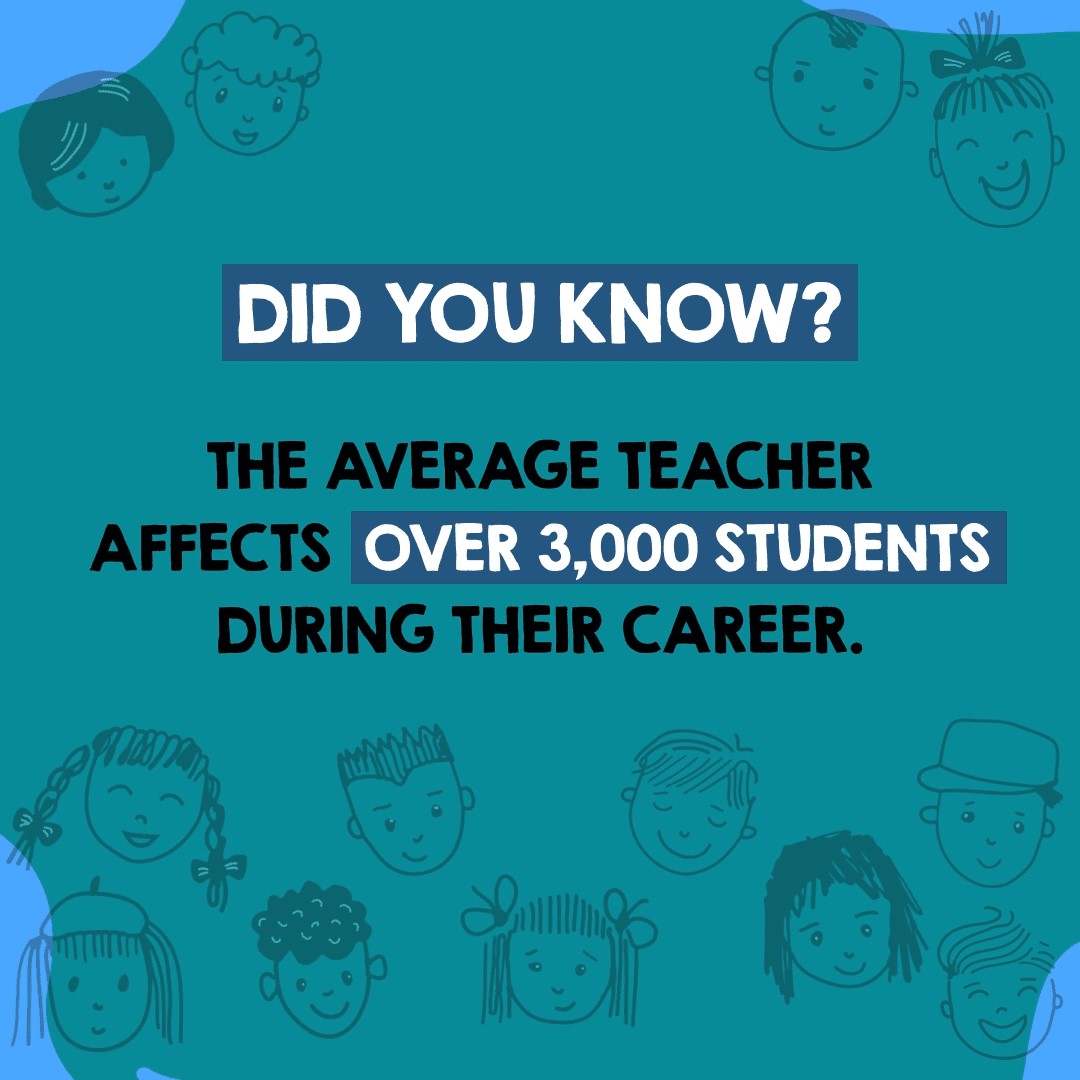Finding the Perfect Balance: Make The Most Of Teacher-led and Student-Led Method In Your Classroom
15th January 2024

Teaching is one of the noblest professions which comes with lots of responsibilities. We often think that teachers have only one task to fulfill which is teaching lessons to their students, but it’s more than that. Teachers also help students to thrive in every aspect of life other than in their academics. According to weareteachers.com survey, we can witness that an average teacher impacts over 3000 students.

Source: weareteachers.com
While talking about the student’s learning journey, the way of learning of every student change as time goes and teachers also need to update their teaching methods with time as well.
There are various alternative methods of teaching like teacher-led and student-led approaches which you can consider to use for creating a more engaging learning environment for students.
In this blog post, we will be exploring the concepts of teaching-led(TL) and student-led(SL) in detail, the benefits of the student-led approach, and strategies to implement in your classroom effectively while finding the right balance to use them both.
Before moving to the topic, can we ask you a question? Do you follow us on Social Media? We regularly share upgraded educational content, tips, feedback, and more. Check us out by clicking the profiles here - Facebook / Twitter / LinkedIn / Pinterest / Instagram / YouTube
So, without any further delay, let’s get started.
Understanding Teacher-led (TL) and Student-led (SL) Approaches
Teacher-led Approach
The teacher-led approach is one of the common approaches that teachers use to teach their students. This approach focuses on the teacher as the central figure within the classroom. Teachers teach their lessons with the help of a board, interactive whiteboard, or projector while teaching with the help of a visual medium. In this method, students generally follow the curriculum set by teachers and follow directions switch teachers gave them throughout their learning process.
Student-led Approach
The student-led approach focuses on making students an independent learner. In this method, teachers help students to learn by themself and also make them capable enough to track their own learning performance, development, and achieving learning goals. The student-led approach may involve organizing desks into pods or groups which fosters collaboration and active participation of students.
Compared to the teacher-led approach, the student-led approach makes the classroom environment a more dynamic and livelier atmosphere. Students in a student-led approach were encouraged to conduct their own research related to different topics and often discuss it with their peers and teachers for better clarity.
This creates a learning environment that makes students fall in love with the learning process, motivates them to engage with learning material, and becomes accountable for their own academic learning journey.
Differences Between Teacher-led and Student-led Approaches
The teacher-led approach has the teachers as the main source of knowledge followed by a curriculum prepared by them that students should learn through. In the same manner, evaluation of students’ progress is usually done through standardized tests and examination outcomes under this technique. The idea behind it is to offer a safe and familiar environment for all students, since each one of them will know what to expect from every class during their entire school session.
However, on the other hand, student-led approach instills more ownership, responsibility and independence on learners for their learning. Again, this method allows them to progress at their own pace throughout the curriculum and enables them understand their learning needs so as they can find any necessary resources needed for their own learning which might need help from a teacher. This will increase the sense of ownership among students which may enable one to become life-long learners thus enabling self-growth in their lives.
Benefits of Student-led Learning
Both the Techer-led approach and the student-led approach have their advantages, but the student-led method offers several extra benefits for students. Below we have shared a few of the benefits of the student-led approach:
Becoming an Independent Learner
The student-led approach promotes a culture of independent learning whereby students take the initiative in determining what they want to learn and go beyond what is taught in class.
Building Confidence
The student-led approach also helps in building individual confidence since students become responsible for their own learning achievements. Instead of just using test scores and exams as a measure of how much they know, they want to always keep on assessing themselves about their performance and reflect on their learning experiences as a way of building up their self-esteem.
Self-Paced Learning Experience
Incorporating the student-led approach also allow every student to have a unique learning experience tailored to suit his / her particular preferences. This allows them to find out which topics they are interested in and where they require help so that a personalized learning experience can be developed around these factors.
Strategies To Incorporate Both Teacher-led and Student-led Methods
Both teaching-led and student-led method has their own benefit and merit. You can incorporate both methods in a balanced way to improve student’s engagement with learning while providing structured instruction to follow. Below we have shared some of the effective techniques to strike the balance between both methods:
Get to Know Your Students
The very first step is to know every student which will help you to know their learning preferences, interests, and needs. This will allow you to plan your lesson planning more effectively and create a more personalized learning experience for students.
Student Feedback and Input
Make sure you take feedback in regular intervals from your students related to course content, your teaching methods, and their own learning goals. This will help you to prepare your lesson planning and it also helps to ensure that topics that interest students are covered and all the skill gaps are being covered if there are any.
Flexible Instructional Pace
Lastly, you must keep in mind that every student learns at their own pace, so observe every student’s learning pace and according to it offer flexibility in the instructional pace in your classroom. Give your students the freedom to go through learning materials at their own pace and provide support if needed in their learning journey.
Striking Balance Between Teacher-led and Student-led Method
Every student is different from one other and so is their way of consuming knowledge and learning pace. There are various approaches available that teachers can opt for like teacher-led and student-led methods to make the learning journey easier for students.
Those teachers who have pursued courses like MA in Teaching know how to use both teaching approaches teacher-led and student-led methods to help students in their learning journey.
However, in this blog post as well, we have shared various ways to incorporate both teacher-led and student-led methods to make student’s life simpler and improve their engagement with the learning material and interest in their learning journey. So, start striking the right balance between teacher-led and student-led methods and foster a positive and effective learning experience for all.
We believe education should be accessible for everyone. That’s why we don’t charge for our blogs. Find the right course that will help you in your career with us, contact us at - 1800-212-6400. You can mail us at act@asiancollegeofteachers.com
Written By: Sonal Agrawal